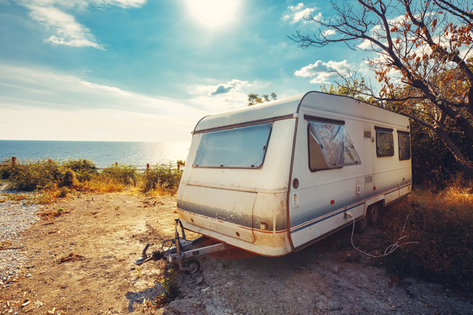
Motorhomes: The Rising Trend Among Celebrities and Influencers
News
Build your business profile for FREE and expose your services to thousands of potential clients!
Create my profile now!
If you're like most caravan owners, you want to ensure that your vehicle is in top condition at all times. Unfortunately, damp can often be a problem, especially during the winter months. In this blog post, we will provide a step-by-step guide on how to fix a damp caravan. Follow these simple instructions and your caravan will be back to its old self in no time!
One of the main causes of damp in caravans is due to the bonding coming apart. Due to how lightweight they are, caravans tend to be made out of fibreglass, wood and plastics which are bonded together where they meet.
Spotting the caravan damp and locating its origins can be a nightmare - water travels easily along horizontal beams, therefore the source of the damp can be far away from where it is visible.
1. One easy way of spotting that you have damp in your caravan is noticing the smell. This will be a musty smell and stale scent that smell damp too, similar to that of a wet towel.
2. Look out for black mould, spots or residue around the doors, windows and roof lights, as well as pinkish or blue staining on the walls. If your walls are damp, it can cause them to feel soft - this is usually an indicator of a serious damp problem.
3. If floors are creaky or spongey, this can highlight delamination which is caused as a result of damp and can be expensive to fix.
4. Keep an eye out for structural damage and also for general wear and tear that could possibly lead to water getting in.
The most common places where caravan damp could be found include:
Along the joints
Awning fixings
Grab handles
Lights
Vents
Beneath the trim
Doors
Window seals
Wheel arches
TOP TIP - If you're inspecting a caravan for any damp issues before you buy it, look out for alterations previous owners may have made such as mismatched wall boards - this can be a sign that there have been previous damp problems.
Do remember that some serious caravan dampness issues may not be easily spotted, so we suggest buying a damp metre. This will help you to track the moisture in the air, helping you to understand if you have a problem. These are relatively cheap to buy online and will save you lots of money further down the line when it helps you to detect a problem early!
We recommend: Brennenstuhl Moisture Detector >> Check the price on Amazon
If you don't feel comfortable attempting to fix the damp in your caravan yourself, then you should take your caravan or motorhome to a registered dealer who will be able to carry out the caravan damp repair.
If your model is under warranty then you're in luck, as it shouldn't cost you anything to have these repairs carried out. But, if it's an older model that's no longer under warranty, then you will have to pay the caravan damp repair costs yourself.
Depending on the state of the damp, this job can end up being relatively expensive. If you have not caught the problem early enough, this could mean that sections of your caravan have to be replaced.
We'd suggest shopping around and getting quotes from a few dealerships first to make sure you're not over-spending.
Before you begin with your repairs, ensure that the caravan is completely dry. Household dehumidifiers are cheap and easy to get hold of. These can remove most, if not all, of the moisture from the upholstery including the seats, carpets and curtains, which can soak up plenty of water.
Use a mould removal spray to tackle areas of mould and mildew. Once this area has dried, combine clove oil with warm water and spray it on the affected area. Leave for 20 minutes and then wipe dry - this will help to prevent it returning in the future.
When it comes to repairing a damp caravan, it's essential to take a thorough approach, and that includes removing and replacing any old, damaged caravan rails.
The good news is, this job can be tackled by just about anyone with a few basic tools and a little patience.
1. First, use a utility knife to remove any sealant around the old rails. Once the sealant has been fully removed, you can start to unscrew the rails from the caravan's body using a cordless drill.
2. Carefully remove each rail by gently prying them away from the caravan body, and be sure to keep track of any nuts, bolts, and washers as they are removed.
3. After the old rails have been taken off, clean and dry the surrounding area thoroughly.
4. Remove any old sealant or grease from the contact surfaces between the rails and caravan - this can be achieved with isopropyl alcohol.
5. Apply a high quality mastic sealant and place your new rails onto the body of the caravan. Make sure to apply pressure until the mastic is visible through the screw holes in the rail.
6. Once the new mastic out is oozing from the holes you should put the screws back in using the same nuts, bolts, and washers removed earlier and tighten until the mastic is again visible around the sides of the screw.
7. Then, wipe off the excess mastic and replace the plastic trim.
Once you have fixed your damp caravan, you will want to check, regularly and thoroughly for signs of moisture. Make sure that your caravan is well ventilated regularly, whether this is on the road, or just a monthly occurrence of letting some fresh air in.
When cleaning your caravan, or after heavy downpours, be sure to regularly check for any leaks.
Cleaning off furniture, carpets, and fabrics before storing them is essential. Moisture in small spaces, like caravans, is an issue that could cause mould or mildew to grow over time. To help keep your caravan free of damp and ensure fabric materials don’t grow corroded, ensuring furniture and fabrics are dried after exposure from the outdoors is suggested before storing. Reducing clutter and taking a few simple steps like this helps maintain the condition of your leisure vehicle.
If you're leaving your caravan empty for a long period of time, make sure to leave cupboards open and remove any cushions, mattresses or other removable upholstery. If you are using a cover, make sure it is waterproof and breathable to help to prevent water ingress.
While on the road, there are also things you can do for long term wet weather damp prevention:
Avoid drying clothes inside your van, use the awning instead
When cooking, place lids on saucepans and make sure windows are ajar
Keep a window open when you shower and make sure the door is completely shut to stop the moisture reaching other areas of the caravan
Always have a dehumidifier handy to fend off moisture

